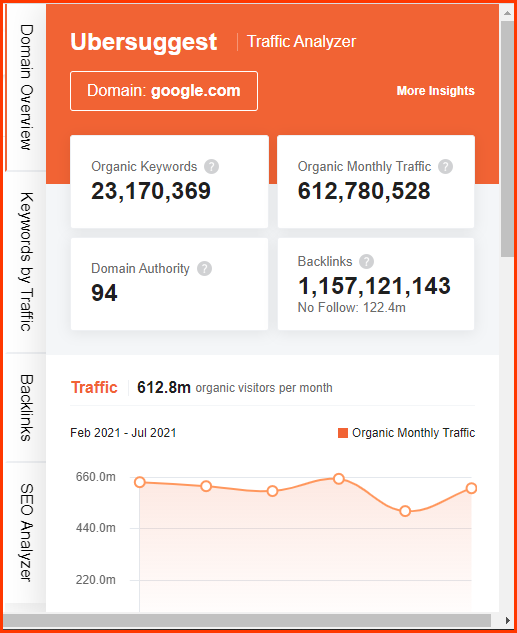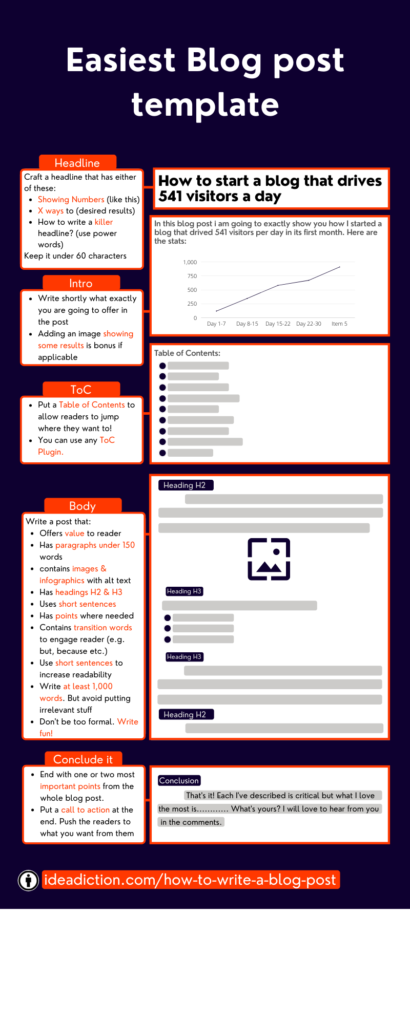I’m going to tell you exactly how to write a blog post that:
- Takes lesser time to write
- Drives traffic
- Ranks fast on google
- Gets backlinks
- Engages readers for long
- Follows simple and easy process of research and writing
The list doesn’t end here. I will provide you a real time workflow of my blog post writing process & blog post template too. It will work even if you are an absolute beginner.
You can follow the same process to write your own blog posts.
These easiest steps will really make your blog writing process faster than ever. Let’s get into it straightaway!
(The steps are never thumb rules. You can change the order and the approach according to you choices and ease. Enjoy!)
Select and narrow down the topic
Write on a topic that is relevant to your interests. First thing even before starting a blog post is asking yourself some questions:
- Is it relevant to my niche of interest?
- Do I really love or even like to write on this topic?
If an answer is no, leave that topic.

If yes, you should proceed and narrow down the topic.
Never write on a generalized topic. Like this same post could be like “How to write?” Does it make sense and will rank ever? The answer is big NO! We cannot cover everything that relates to writing here.
Even if you are a freelance writer, never try to cover everything under the sun. Stay specific to your area of interest. You will love writing about that.
So, I’ve specified it to write a blog post. And not for all who want to write a blog post. But only for those who want to drive more traffic and get more engagement.
Research the topic
Once you are done with selection of topic. You need to research about:
- The target keywords
- Search volume
- Competition
- Relevant blog articles
Let’s get further into it.
Research the target keywords
You cannot put random keywords to rank. It’s because:
- Some could be highly competitive
- Some could never have been searched on google
So, you need to perform proper research before starting writing.
For this purpose, you can use my favourite free option “Ubersuggest Chrome Extension”. This is how it works.
While researching for the long tail keywords “How to write a blog post”, I’ve simply searched it on my Chrome. The Ubersuggest Chrome Extension was already there to do the rest for FREE! It provides me the information about Search Volume and Cost Per Click. And yes, it also provides me insights on the relevant long tail keywords.

The low search volume depends upon the targeted niche. For me, it’s 100 per month. SD or SEO difficulty higher than 30 is highly competitive. Change the target keywords until you reach a good combination of search volume and SEO Difficulty.
Search volume
It is the approximate number of monthly searches for that specific keyword. A search volume of 1000 per month is ideal.
But you must also target some keywords under volume 100, and SEO Difficulty under 10. It will work like magic. Here is how. Google will rank you higher for such low searched, less competitive keywords. And when the post is clicked and read, it gets ranked for more competitive keywords.
Competition
Lower the competition, better the chances of higher ranking!
A must-do job for blog post research is checking your intended blog post’s competition. As our ultimate goal is to rank it higher and higher. Ubersuggest extension also tells you the SEO Difficulty (SD) score. If the score is less than 30, you can rank it relatively easier.
If it is 30+, then only write if you are writing for something like google or forbes :p
Read at least10 relevant blog posts
Now, we are done with research about keywords and rankings.
It is time to start gathering more knowledge. You are having some sound knowledge already. But you need to check what others are writing and what they are not. You will find the missing points from there. Write on a side what others are missing in that topic. And focus those points to write a more detailed and a better blog. But never the similar one!
Let’s move towards the very step on how to write a blog post.
Outline the blogpost contents
Now it’s the first practical step in this ultimate guide on how to write a blog post to boost the ranking.
Start outlining the contents while researching and give them an order when you are done with the research for the blog post.

Have a look over every point you noted during the research. Create a draft outline first which is flexible enough to change at any point during the writing process. Many points need a removal and many need to be added. So don’t be rigid here.
The very next step is creating a killer headline. Let’s get into it
Craft a killer headline
A headline is what drives or kills the traffic. The users will only click only if your heading compels someone to do so.
It should trigger some emotion so that the user might be converted into the visitor and then ultimately into the customer. Isn’t it your ultimate goal? How have you been converting till now? Let me know in the comments.
Your headline can have some powerful words like:
- Emotional words
- Positive words
- Negative words
These are pretty much similar and sometimes mixed. Here are 800+ power words by smart blogger.
Here are some examples of some of the great headlines:
- 30 “Proven” Ways to Make Money Online Blogging (Power word: Proven. By WP Beginner)
- How to Make Money Blogging in 2021 ($203k in Year One) (Hooking thing: Mentioning the earned money)
- 30 Most Lucrative Skills You Can Learn Online (Power word: Lucrative. By Online course report)
Remember that the headline should not exceed 60 characters. Otherwise google will not display it fully in search results. Like this:
Write a short but compelling intro
Here we actually start writing a blog post! Write an intro that hooks the visitor and compels to read the whole blog post. Everyone visits the blog website to gain something.
Tell them what value you are going to offer them.
Tell the readers what exactly you are going to provide them in the blog post
Don’t forget to use your targeted keyword in the first paragraph of your intro.
Take some time to craft a great intro. You can write it at the end so that you might be able to exactly tell your visitors what you are going to offer. Keep it short. The word count should not be more than 200 words. Below is how to proceed with the post:
Continue with writing the blog post
You’ve already researched everything.
You’ve knowledge and everything you need to write a complete blog post on the topic.
But these are some of the important things you’ll want to definitely consider while writing a blog post:
Make sub-headings
No one wants to read some boring text-dense page. So you need to divide your post into headings.
Your text should not exceed 150 words without a sub-heading. It returns the best results in terms of engaging the reader.
Divide each sub heading content into two or three paragraphs.
Add images and infographics
Another very important part of a blog post is adding images and infographics. I’m very lazy at this 😛
But:
So, add images that are relevant and describe your stance.
Another great way to engage the readers is adding infographics in your post.
And yes! Don’t forget to use Alt texts in your image. These Alt tags help in ranking your blog post in Google image search, and help in overall SEO.
Add transition words
Transition words help in keeping the reader engaged while reading your post. It is because when the reader reads a transition word, he/she has a reason to read more of the post. Some good examples of transition words are:
Because, but, how, in spite of, after that, specially, similarly, as a result etc.
Here is an example from Yoast:
In this image, did you notice any difference? This is what a reader gets engaged with and without the transition words. Let’s get into the keyword density:
Optimize for targeted keywords
It is important to note that you need to use the keywords for which you want to rank the post. Use them wisely.
Don’t over optimize your blog posts.
Use the keyword once for every 200 words. It will return the good results.
Now we are going to talk about polishing your blog post.
Link back to resources
You must have used information from some other websites or articles to write a perfect article. Link back to these to maintain your credibility. It helps in SEO of your blog post. Try to link back to authoritative websites.
Internal linking
You must have other relevant blog posts. Why not link back to those posts to keep the reader inside your blog? Use internal linking to up your chances of ranking the blog post.
Formatting your blog post
In this section, following things are important to consider:
Firstly, use as many H2 and H3 headings as you can. These help in ranking. And more importantly, the snippet posts like this are due to sub-headings H2 & H3:
So, make use of the sub-headings.
Secondly, use images, and paragraphs.
Thirdly, don’t hesitate to bold the text, use quotes like this, and highlight where you want to get more attention from the reader.
- Use bullets in your posts where possible. They increase readability.
Conclude
The last thing in your writing process should be concluding your blog post. Well it can be intro as well. Some people write the intro at the end.
While concluding, ask your readers to comment about your blog post. Google loves to rank the posts with more engagement. Because people only talk about the things they really like. I love the way Brian Dean concludes his blog posts at Backlinko. Here is how he does that:
Call to action
Now it is time to get something more from your reader. If you are selling something, ask your readers to buy these. But never say that in a way you are trying to force.
Ask your visitor some questions relevant to your current post. If they reach the end of your post, they will surely love to comment about that once you give some push. The comments are really important for your blog post’s SEO. This was all about how to write a blog post. But there is a final all important step. Here it is:
Proofread, check for SEO and Publish
Proofread for some grammatical or spelling mistakes. Use some software like grammarly while writing your post. Delete the parts that are unnecessary. Add where you need the information is incomplete.
Now comes the SEO:
Here is a checklist for your blog post’s SEO:
- The blog post is 800-1000 words long
- The blog post contains internal links
- It contains links to external sites
- There are images with alt texts in the blog posts
- You have put right amount of Target Keywords as mentioned above in the post
- A good number of sub headings is there in the blog post
- There is no paragraph bigger than 150 words
Blog Post Template
Here is an easiest-to-follow blog post template even for absolute beginners.

What’s your take on it?
I will love to know your take on this blog post on how to write a blog post to drive more traffic in 2021. I will like to know:
Which step have you been missing out of these?
Or do you think anything is missing here? Please let me know about that. All the best!




